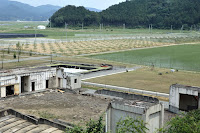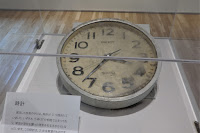Elementary school ruins in northeastern Japan restored as disaster memorial park (2)
The place where the Kamaya community existed was designated as a disaster-prone area after the disaster. Currently, land around the school ruins is entirely designated as a nonviable place to live.
No houses and residents are seen around the school ruins, but visitors can see some land tracts near the school newly cultivated for farming.
Lying just east of the school ruins is a 2.5-hectare olive tree field. Young olive trees are planted orderly in the field, managed by a company set up jointly by three local farmers.
<Japan's northernmost olive tree project aimed at rehabilitating disaster-hit areas>
The olive tree growing project was launched by Miyagi Prefecture in 2014 as part of efforts to rehabilitate areas designated as uninhabitable places after the disaster. Kamaya is one of six locations selected for the project in the prefecture.
Edible olive oil began to be produced from the trees in 2019. The volume of crop is still limited, but the produce from the fields is already shipped as extra virgin olive oil, said an Ishinomaki City official in charge of the project.
The undertaking is known as Japan's northernmost olive tree growing project. Kamaya is situated latitude 38 degrees 32 minutes north.
Seen beyond the olive tree field is the back side of the school ruins, among them the collapsed corridor connecting the second-floor classrooms and the gym.
The series of efforts to resuscitate the tsunami-damaged areas in the city followed hard discussions between the city authorities and affected people, which led to a court battle involving the families of 23 dead Okawa Elementary pupils.
A damages suit filed by the bereaved families against the city and the prefecture in 2016 focused on an allegedly poor knowledge about a school manual for evacuation among the school staff.
The plaintiffs argued that because of the improper behaviors of teachers who were at the scene, the children and residents involved had to stay at the schoolyard for as long as over 50 minutes after the occurrence of the quake.
A major tsunami warning had been issued to the Kamaya area soon after the tremor was felt at 2:46 p.m., and the tsunami is believed to have reached the school about 50 minutes later. This means that little time had been left before the children and others started evacuating from the school, led by the school staff. With her red satchel on the back, Hana was obviously among the evacuees there.
The time when the tsunami reached the school can be seen with the classroom clocks recovered from the debris. One of those clocks, displayed at the memorial hall, had stopped at 3:37 p.m., indicating the wave began to engulf the school at that time.
The argument by the plaintiffs was upheld by a first-instance court and by an appeals court again. The plaintiffs finally won the case in 2018.
The Okawa Elementary incident is said to be the worst case involving children sacrificed in a school-managed situation in Japan's postwar history.
<Okawa Elementary incident seen to be remembered in Japan's anti-disaster efforts from now on>
One community and its beloved elementary school vanished with a stroke of tsunami which had travelled 3.7 kilometers back from the river mouth. Many schoolchildren and their voices disappeared.
Bereaved families and former residents of Kamaya as well as public-sector people, notably Ishinomaki City officials, underwent many twists and turns before reaching a bitter agreement on how to restore or use the damaged community and what to do in honor of the dead.
Their hard memories are unlikely to be wiped out easily, but their experience should be remembered by people concerned all the time from now on, as Japan is determined to strengthen its anti-disaster systems and improve disaster prevention education for the public in the years ahead.





No comments:
Post a Comment